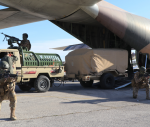You are here
Youth and women ‘left behind’ in Arab region development progress — UNDP
By JT - Mar 23,2017 - Last updated at Mar 23,2017
AMMAN – Despite significant progress in human development over the past 25 years, Arab countries have the highest youth unemployment rate and the lowest number of primary school-aged children attending school, in comparison with other developing regions of the world, a United Nations Development Programme (UNDP) report stated.
These findings were released in a UNDP report titled ‘Human Development for Everyone’ that sought to evaluate the impact of development barriers on various demographical groups, with a focus on youth and women.
The report found that although average human development improved significantly across all regions from 1990 to 2015, one in three people worldwide continue to live in low levels of human development, as measured by the Human Development Index (HDI). And Arab states were designated as some of the weakest in terms of equal development for all sections of society.
“The world has come a long way in rolling back extreme poverty, in improving access to education, health and sanitation, and in expanding possibilities for women and girls,” said UNDP Administrator Helen Clark, speaking at the launch of the report in Stockholm. “But those gains are a prelude to the next, possibly tougher challenge, to ensure the benefits of global progress reach everyone.”
In the Arab states, over half the population is under the age of 25. Yet, the percentage of children of primary school age currently in school was found to be the lowest in the developing world.
Youth unemployment was also pointed out as the highest among developing regions, with 29 per cent of individuals between 15 and 24 currently out of employment.
The report also found out one of the widest gaps between male and female’s positions in the Arab world. Women in the Arab states still suffer from dire inequalities. The difference between the HDI values for the female and male population in this region, as measured by the Gender Development Index, is the second largest across all developing regions, the report showed.
Regarding employment rates, the region displayed the largest gap between male and female labour participation rates. Only 22 per cent of women aged 15 and older were employed outside the home in 2015, compared with 75 per cent of men.
The report noted the grave consequences of regional crises, including five years of civil war in the Syria, the spillover into Egypt, Iraq, Jordan, Lebanon and Turkey, highlighting the impact of such events on human development levels. Refugee children and adolescents are five times more likely to be out of school than their non-refugee peers. Refugees also tend to face more barriers to access work and political participation, the report noted.
Countries hosting people fleeing conflicts and violence are also affected, especially Jordan and Lebanon, which have taken in the vast majority of Syrian refugees.
The UNDP report called on greater attention to the empowerment of the most marginalised individuals in society.
“As this report notes, in order to ensure that no one is left behind, the region needs to focus on those excluded and on actions to dismantle deep-rooted and often unmeasured barriers to development,” said Mourad Wahba, UNDP assistant administrator and regional director for the Arab States.
“By eliminating deep, persistent, discriminatory social norms and laws, and addressing the unequal access to political participation, which have hindered progress for so many, poverty can be eradicated and a peaceful, just, and sustainable development can be achieved for all,” Helen Clark added.
The report stressed the importance of the 2030 Agenda for Sustainable Development to build on human development gains, noting that the agenda and human development approach are mutually reinforcing.
Related Articles
The Kingdom has maintained its ranking in the Human Development Index (HDI) for the past two years, standing in 77th place, according to a recent report.
AMMAN — The United Nations Development Programme (UNDP) on Monday launched the global Human Development Report, a blueprint for development
AMMAN — Helen Clark, administrator of the United Nations Development Programme (UNDP) and chair of the UN Development Group (UNDG), arrived















